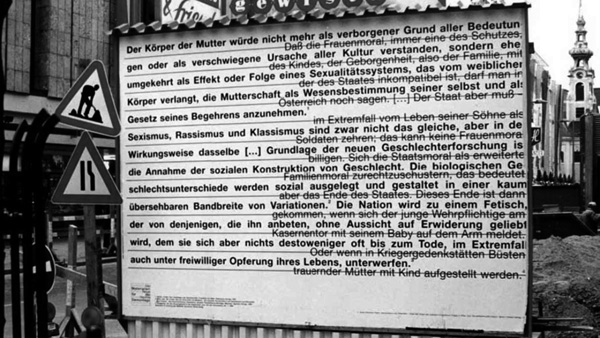Is art assuming the function of the political in present-day society?
Martin Krenn: Roger Behrens
I’m not so sure that one can speak of the function of the political being assigned to art. For me personally it was an arduous process in countless small steps until I managed to stabilise my living situation as a “political artist”. Selling art alone was very difficult, and that’s why I’ve extending the reach of my artistic practice to include working at schools and universities. In my experience, art that takes a critical position on both state and society as well as the established art business always has a hard time of it. I believe that this situation hasn’t changed today, one shouldn’t be deceived by the success of a few less politically and socially engaged artists. Moreover, most of the socially engaged projects, such as those successfully shown at diverse biennales in the 1990s, are scarcely still in demand today. It was 1995 when I realised my first large project “Die neue Rechte – Materialien für die Demontage” together with Oliver Ressler in public space. Montaging quotations, our poster series targeted New Right ideologies. Back then there was little understanding for such overtly political art. There was even discussion about whether it was appropriate for artists to do something like that. One suggestion was that we should weigh the printing ink of the letters and relate it to the weight of the political statement on the poster. Only then could one speak of art. These were the kind of ideas put forward. In Vienna, a broader politicizing of art finally took place in the 2000s, in response to the FPÖ, Jörg Haider’s right-wing populist and anti-immigrant party, coming to power. This wave of politicization abated however after a year. One group that was much discussed in Austria during the 1990s was Wochenklausur. This group insisted that art had to combine social and civic engagement with real change. Many in the Vienna scene smiled at this, and even today Wochenklausur, despite considerable international success, has little or no significance for the Vienna art establishment. In the 1990s there was one development that led to an institutional/organisational basis for socially engaged artists, but also to a polarisation in terms of how it was judged, one that still exists today: artists, activists and theorists formed collectives with the aim of realising socially engaged and political projects, but as a consequence the detractors fundamentally rejecting such an understanding of art grew as well. Collective and engaged art was perceived as a threat to art and aesthetic autonomy. Since then the fronts have hardened: a certain inflexibility is discernible in the field of engaged and political art, there’s an inert deference to the criteria of “political correctness”, while opposed to this, it is denied that such art could have any form of aesthetic value, so it is expected that political art is to resist every form of “political correctness”. Art would then be political when it proves capable of shocking the viewer’s moral sensibility. But I don’t think that social and political art can be separated from either the aesthetic or the moral sphere. It would be interesting for me to see if one could translate Adorno’s conception of the autonomy of art onto the current situation. Adorno’s idea of aesthetic autonomy is that it – outside the constraints of society, outside the administered world – is able to mediate the semblance of a different life. What’s your take on this?
